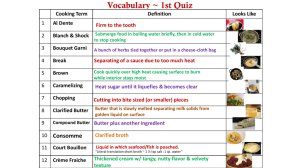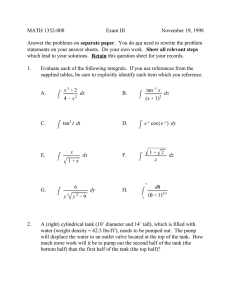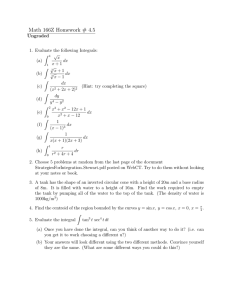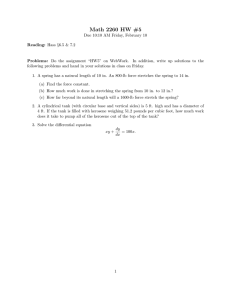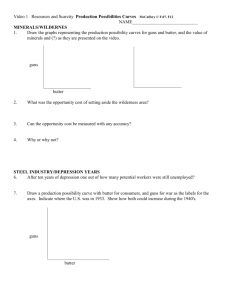Effect One of the greatest sources of contamination in creamery ... ter is that of impure wash...
advertisement
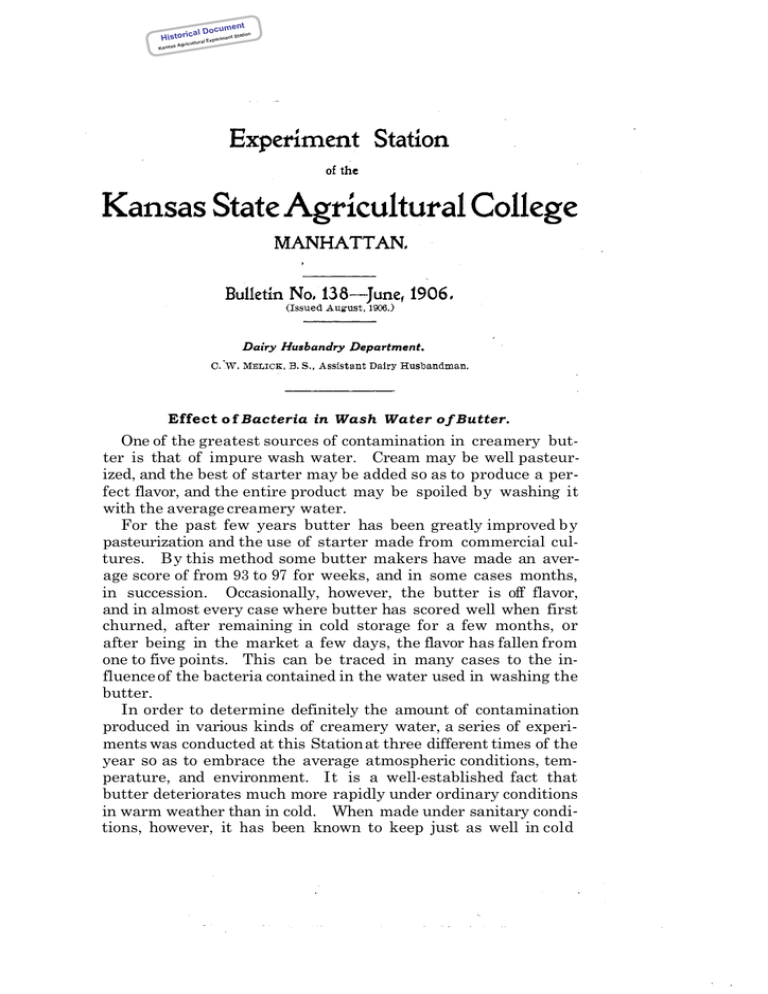
ument c cal Do Histori ultural Agric Kansas Experim on ent Stati Effect o f Bacteria in Wash Water o f Butter. One of the greatest sources of contamination in creamery butter is that of impure wash water. Cream may be well pasteurized, and the best of starter may be added so as to produce a perfect flavor, and the entire product may be spoiled by washing it with the average creamery water. For the past few years butter has been greatly improved by pasteurization and the use of starter made from commercial cultures. B y this method some butter makers have made an average score of from 93 to 97 for weeks, and in some cases months, in succession. Occasionally, however, the butter is off flavor, and in almost every case where butter has scored well when first churned, after remaining in cold storage for a few months, or after being in the market a few days, the flavor has fallen from one to five points. This can be traced in many cases to the influence of the bacteria contained in the water used in washing the butter. In order to determine definitely the amount of contamination produced in various kinds of creamery water, a series of experiments was conducted at this Station at three different times of the year so as to embrace the average atmospheric conditions, temperature, and environment. It is a well-established fact that butter deteriorates much more rapidly under ordinary conditions in warm weather than in cold. When made under sanitary conditions, however, it has been known to keep just as well in cold t cumen on cal Do Histori ural Experiment Stati Kansas Agricult storage during July and August as in January or February. Deterioration in butter is caused by the growth of undesirable bacteria, enzymatic ferments, or by exposing to warm temperatures. Bacteria are introduced either in the cream before churning, the wash water, an excess of buttermilk, or wash water left in the butter, or by the use of unclean dairy utensils. A study of the amount of contamination from various forms of bacteria, their habit, method of contamination and their prevention and destruction was investigated in the following manner: A quantitative bacteriological analysis of all water coming in contact with the dairy utensils, churn and butter was made under average conditions. A churning of butter was washed with the creamery water at the usual temperature. One sample of the butter was kept in cold storage and another in normal room temperature. Both samples were carefully watched and scored whenever any noticeable change occurred. Another churning was made at the same time and washed with the creamery water coming from the same source, but having been previously sterilized and cooled. Samples of butter washed with the sterile water were stored under the same conditions and as carefully watched as those of the previous churning. Water was treated in various ways in order to arrive at the proper methods for the most effective control of the germs it contained. The quantitative analyses of bacteria were obtained in the following way: One-tenth cubic centimeter of water was drawn into a sterilized graduated pipette and transferred to a water blank test-tube containing .9 cubic centimeter of sterilized water. After shaking well, one-tenth cubic centimeter of this was transferred in the same way to a test-tube containing sterilized agar medium, well mixed, and poured into a petri dish. The solution then contained one onehundredth cubic centimeter of the original water, and the number of colonies that developed in each dish was therefore multiplied by 100 to obtain the average number of bacteria per cubic centimeter. Some samples were sterilized and some pasteurized and allowed to remain warm, others cooled gradually. Some were rapidly cooled to 50° or 55° F., depending on the time of the year, and used immediately after cooling. Otherwise they would likely become contaminated again from the surrounding atmosphere or vessels used in handling. Water was also filtered through eight inches of mineral wool and the number of bacteria removed was ascertained. In some cases hydrant water at 60° to 70° F. was used without filtering or change of temperature. Water was also ument c cal Do Histori t Station perimen ural Ex Agricult Kansas collected from the refrigerator drain where it flowed from the melted ice. It is here utilized for cooling purposes and often comes in contact with various dairy utensils. The ice used was all manufactured, and the ice-box was kept fairly clean, to comply with average creamery conditions. The following table illustrates the number of bacteria per cubic centimeter found in the creamery water. This water comes from the College water-supply, which is pumped from a sixty-foot well into an elevated reservoir. With the exception of the samples obtained from melted manufactured ice, the water was all taken from the same original source. ument c cal Do Histori t Station perimen ural Ex Agricult Kansas By closely observing the above tables we notice that during September samples No. 2 (filtered water) contained a smaller number of bacteria than samples No. 3 (unfiltered water), while during the greater part of March and June the reverse was true. The filter was put in clean September 1 and filtered from one-fourth to ument c cal Do Histori ultural Agric Kansas Experim ent Stat ion one-half of the bacteria out of the water for a few weeks. Later it not only failed to fi1ter out bacteria but contaminated the water passing through with millions of additional germs. It will also be observed that whenever samples No. 1 (sterilized, filtered, cooled water) were allowed to reach a high temperature, as in the cases of March 5 , June 18 and 20, a very high germ content was found. The water, though sterilized, filtered, and cooled, was filtered through a badly contaminated filter, and when allowed to warm up a little the bacteria multiplied very rapidly. The accompanying cuts serve to illustrate the relative number of bacteria in the different samples of creamery water. Plate N o . 1 represents the average number of bacteria per c. c. in water having been sterilized and immediately cooled. Plate No. 2 represents a sample of the same water after having remained in the filter tank five hours at 75º F. In the use of sterile water we have noticed a marked improve- ument c cal Do Histori ultural Agric Kansas Experim on ent Stati ment in the keeping quality of our butter and in the flavors which developed later, providing the water was cooled and used immediately after sterilizing. When the wash water was properly sterilized our butter topped the market every time, and sold for from 1 cent to 3 cents more per pound than did the samples of butter which had been washed with unsterilized water. The ex- PLATE 11. pense of sterilizing the water was practically nominal, requiring only a few pounds of steam and time enough to open the steam valve to admit it into a water tank made for the purpose and, after sterilizing the water, to close that valve and open an outlet where the latter was admitted to a cooling tank. Figuring the cost of fuel for production of steam necessary to sterilize wash water for 1000 pounds of butter in the average creamery at 15 cents per day, ice for cooling it at 25 cents per day, and extra labor in handling it at 10 cents per day, amounts to 50 , . ument c cal Do Histori riment al Expe ur Agricult Kansas Station cents. Where 1000 pounds of butter per day are made, which sells for 1 cent more per pound on account of the use of sterile water, it amounts to $10. Deducting 50 cents for labor, steam, and ice, we have left $9.50 profit per day. These figures are very conservative and allow for a considerable loss of steam and ice. For instance, 1 pound of $3.00 coal furnishes enough heat to produce about 8 pounds of steam in the average boiler. Approximately 152 pounds of steam at 75 pounds boiler pressure are required to raise 1000 pounds of water from 60° F. to 212° F. To sterilize 2000 pounds of water, or enough to wash 1000 pounds of butter, therefore requires 304 pounds of steam. This, according to the above, requires 38 pounds of coal at $3.00 per ton, amounting to almost 6 cents. The figures for ice and labor are equally conservative. From this it is very evident that it is entirely practical and economical to sterilize wash water for butter, and butter so made is more wholesome for the consumers. All of the samples No. 4 were taken from a hot-water tank on the second floor of the College Creamery. The water was heated by direct steam connection. After heating to desired temperatures, it was allowed to flow into a horizontal filter tank. This tank is 12 feet long, 2½ feet wide, and 2½ feet deep. Eight inches of mineral wool was placed between close-fitting perforated tin plates, across the center of the tank. All of the samples No. 3 were obtained from the first half of this tank before being filtered. All of the samples No. 2 were obtained from the latter division of the tank after being filtered. The samples numbered 1 were taken from the same water after it had been allowed to circulate through a series of inch pipes in the ice-box. With this arrangement the College Dairy Department considered itself well equipped for obtaining practically pure water for laboratory purposes and for washing butter. From the results of these experiments, however, the water treated as above described proved little or no better in many instances than the average untreated hydrant water. This is due to the fact that the water did not always run in a continuous stream from the hot-water tank through the filter tank into the refrigerator coil pipes. When allowed to remain a few hours in the filter tank, even though tightly covered to exclude the air, the conditions at such temperatures as existed there (70° to 110° F.) were so favorable to the growth of bacteria that they increased with great rapidity, and after the tank and filter plates had remained unwashed for a few months they became practically innumerable. It will be noticed that ument c cal Do Histori riment al Expe ur Agricult Kansas Station there is a decided increase in the number of bacteria in the samples of water from both sides of the filter tank (2 and 3), especially No. 2 (after filtering). This is due to the fact that the filter plates were not changed from September 18, 1905, until the end of the experiment, June 25, 1906. This furnishes conclusive evidence that a filter removes only a small proportion of bacteria in water when new or frequently changed, but is only a source of contamination when used continuously for a few months without changing the filter material. Samples No. 5 were taken from untreated hydrant water, while samples No. 6 were obtained from the tank into which the water from the melting ice of the refrigerator drained. In the bottom of this tank was inserted an overflow pipe so as to allow the water to rise to the neck of a ten-gallon milk-can before passing out. This system retained the water several hours and permitted a rise of temperature and a considerable amount of contamination even although it was guarded with a close-fitting cover. It will also be noticed that there is a decided decrease in the number of bacteria present in the water melted from ice between September and June. This is explained by the difference in the use of the tank, and in the time of the year in which the samples were taken. For instance, the drain was used continuously through the summer and the drain water reached a higher daily temperature during warm weather than in winter, and the wooden tank into which it drained became so badly contaminated that the water was filled with germs shortly after entering. After remaining unused and at a low temperature through the winter until March 1, the tank seemed to have been comparatively free from germs. On September 23 the tank was drained out and thoroughly washed. As a result the number of germs in the water was reduced from 100,000, on the 22d, to 180, on the 23d. The lesson to be drawn from this is that water, whatever its source, may become unfit for washing butter or rinsing dairy utensils in a few hours unless kept below 50° F. and in a scrupulously clean vessel. The scores of the butter washed with water treated by the various methods are given in the following table. Samples No. 1 were washed with water-samples No. 1 (heated, filtered, and cooled); samples No. 2 were washed with water-samples No. 3 (heated, unfiltered water). In some instances the water was sterilized and in some instances pasteurized. Samples No. 3 were washed with untreated hydrant water from the same source. Only pasteurized cream was used in these experiments. cumen cal Do Histori Kansas ural Agricult Experim t on ent Stati ument c cal Do Histori Kansas ural Agricult ent Experim Station ference in the bacterial content of the pasteurized and sterilized wash water or their effect upon the keeping quality of butter washed by them. This experiment represents average creamery conditions, and the germ content of the samples of this water is much greater than would have been the case if the water had been sterilized and immediately cooled to a low temperature. On the contrary, it was allowed to flow through the filter tank and remain there several hours. When the water was rapidly cooled after heating, the best results were invariably obtained. CONCLUSIONS. 1. It is both practical and economical to sterilize wash water for butter if it can be cooled and used immediately. Otherwise, the practice is a useless expense. 2. A filter for creamery water is only a source of contamination and filth unless frequently cleaned and refilled with fresh filtering material. 3. Water melted from ice, even though kept at 50° F., may become filled with bacterial growth if allowed to stand for a few hours in a wooden tank from day to day without thorough cleaning. Great care should therefore be taken in the utilization of such water for cooling purposes. 4. There is a direct relation between the bacterial content of the wash water used and the keeping quality of the butter. 5. Water kept at a low temperature from 40° to 50° F. for a few hours inhibits the development of bacteria, or destroys from onehalf to four-fifths of those present. .
